A team of international scientists has created a more sustainable method for making green fertilizer. Led by Nanyang Technological University, Singapore (NTU Singapore), the researchers focused their investigation on a key compound in fertilizer called urea. This is a natural nitrogen-rich substance found in the urine of mammals. It’s used in commercial fertilizers to increase crop yields, but traditional methods to create it require immense energy.
The current Haber-Bosch method of making urea doesn’t coincide with a more sustainable world. The process converts hydrogen and nitrogen into ammonia, which forms the base of commercial synthetic nitrogen fertilizers. While it’s arguably among the most impactful industrial chemical reactions in history, it takes a huge toll on the environment.
The chemical reaction requires temperatures around 500 degrees Celsius and pressures of 200x sea-level atmospheric pressure. This creates a huge carbon footprint, accounting for approximately 2% of global annual CO2 emissions. To put that in perspective, the Haber-Bosch process emits more carbon dioxide than any other chemical reaction. What’s more, it consumes nearly 5% of the world’s annual natural gas production to create hydrogen and generate heat.
So, the NTU researchers wanted to devise a more eco-friendly way to make green fertilizer. As global food demand increases, it’s of utmost importance to practice sustainable agriculture. The team believes the findings of their research may help agricultural companies reach this goal.
To make green fertilizer more efficient, scientists turned to an already-existing urea production method. Known as electrocatalysis, this process uses electricity and potentially sunlight to trigger chemical reactions in a solution. While producing urea this way requires less energy, it historically hasn’t produced enough to replace the Haber-Bosch method.
How scientists made green fertilizer more sustainable and efficient
 So, to improve the alternative method, scientists used nitrate instead of nitrogen to bond with carbon dioxide. They used the nanomaterial indium hydroxide as a catalyst solution. Scientists discovered that this process produced urea for green fertilizer five times more efficiently than previous attempts using electrocatalysis. Not to mention, the improved method created a greater output of urea than the older process.
So, to improve the alternative method, scientists used nitrate instead of nitrogen to bond with carbon dioxide. They used the nanomaterial indium hydroxide as a catalyst solution. Scientists discovered that this process produced urea for green fertilizer five times more efficiently than previous attempts using electrocatalysis. Not to mention, the improved method created a greater output of urea than the older process.
Co-lead author of the study, Professor Alex Yan from the NTU School of Materials Science and Engineering (MSE), said, “Our method essentially manipulates the chemical reaction process to become ‘highly selective.’ By picking a better catalyst, we helped the nitrate ions and carbon dioxide molecules to optimally position themselves to facilitate urea formation while suppressing the creation of unnecessary by-products like hydrogen, leading to higher efficiency and better urea yields.”
The international research team includes researchers from Texas at Austin, University of Science and Technology of China, and Harbin Institute of Technology, China. The study findings have been published in the peer-reviewed scientific journal Nature Sustainability in July. Also, NTU patented the alternative urea production method to make green fertilizer.
Researchers say the improved urea production technique may pave the way for sustainable chemistry in the future. They also hope it will inspire more eco-friendly agricultural methods to feed the rising global population.
The study provides evidence of the university’s pledge to address humanity’s greatest challenges on sustainability. Called the NTU 2025 strategic plan, it aims to transform scientific research into technological advancements to heal our planet.
The new method for making green fertilizer can compete with the Haber-Bosch process
Scientists tested the efficiency of their improved method in the lab as a proof of concept. They discovered that the process resulted in a urea yield of 53.4%. Luckily, this makes it competitive with the traditional Haber-Bosch method, which transformed agriculture in the 1910s.
The two-step thermal process relies solely on fossil fuels and requires extremely high temperatures to create a reaction. It also needs high-pressure conditions, making it unsustainable and environmentally destructive. The first step of the process uses nitrogen and hydrogen to make ammonia. Next, it’s bonded with carbon dioxide to form urea.
In comparison, the new method of creating green fertilizer requires far less energy and complexity. For starters, the technique requires only one step instead of two. It takes much less energy to break the bonds of nitrate than nitrogen, which helps produce higher urea yields. Combined with carbon dioxide and hydrogen, the process triggers urea formation at room temperature.
According to researchers, since the method only requires one step, it’s simple enough to scale up. Farmers could easily operate the electrocatalytic device to produce urea for fertilizers. Also, the method could one day run solely on renewable energy, making it even more eco-friendly. The team hopes that large-scale industrial companies will adopt this method to reduce energy use.
The first author of the research, Dr. Lyu Chade, Research Fellow from the NTU School of MSE, said:
“With advances in solar technology, we may potentially use sunlight to power the electrocatalysis process in future, which can further help lower global emissions.”
In the future, the researchers hope to keep increasing yields and improving the catalytic selectivity. To do this, they will research catalysts that would increase reaction speed. Also, they’ll investigate methods to power the process with solar energy. Finally, the team will work to build a prototype device to demonstrate large-scale urea production.
 Final thoughts: scientists are successful in making green fertilizer even more eco-friendly
Final thoughts: scientists are successful in making green fertilizer even more eco-friendly
As the global population continues to grow, scientists have been working on methods to produce green fertilizer. Current processes for producing fertilizer require massive amounts of energy via fossil fuels, which increases greenhouse gases. To create a more sustainable green fertilizer, scientists improved upon an already-existing method known as electrocatalysis.
Using nitrate instead of nitrogen and the nanomaterial indium hydroxide as a catalyst made this process five times more efficient. The team says this formula can apply to both large- and small-scale farming processes. In the future, the team aims to achieve even higher yields and speed up reactions. They also hope to one day power the process using only solar energy.
This groundbreaking research may usher in a new era of agriculture run on clean energy rather than fossil fuels. If the green fertilizer totally replaces synthetic fertilizers, it would reduce global annual emissions by 2%.


















